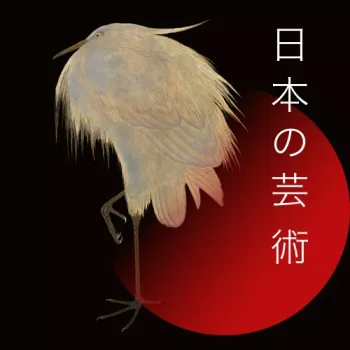Box and cover c. 1800 - 1859
Wood, black and gold lacquer, silk, paper | 9.6 x 44.6 x 16.4 cm (whole object) | RCIN 41541
-
An oblong, rectangular box, with inset rim and shallow, flat-topped cover. The rims gold-lacquered and the interior surfaces polished black; the sides and top decorated in gold on a black ground, with an all-over vine-scroll design, with leaves in a paler tint and open blooms in gold, overlaid with several roundels of prunus blooms with coiled stems. On either side, fitted silver rings attached to bosses for the tasselled ropes of orange-red silk to tie round it, which have been removed and placed inside.
Inside, wrapped in patterned black and gilt paper, is an oblong silver tray (watashi-gane) for tooth-blackening equipment, with thickened rim and lobed, rounded ends, having a pierced panel in the centre and engraved designs, including a minogame turtle and a bird. This tray acted as stand for tooth-dyeing (ohaguro) products, and would have been accompanied by a silver urn and pot. A second wrapper contains a bundle of silver and gold incense sticks.
This box almost certainly accompanied a santana, a group of three open cabinets with an assortment of asymmetrical cupboards and shelves. Until the late Edo period, these lavishly decorated units were reserved for the very wealthiest families. A set comprised a kurodana (for cosmetic boxes), a shodana (for writing equipment and books) and a zushidana (for incense equipment and small boxes). Each cabinet was filled with dozens of matching, smaller boxes like this one, originally intended for a bride's trousseau.The contrasting decoration of gold scrollwork and roundels of peonies on black lacquer matches a zushidana, kurodana and shodana in the Royal Collection (RCINs 26049 and 26051).
Those three shelves were received by Queen Victoria from Shōgun Tokugawa Iemochi in 1860 and described by Sir Rutherford Alcock (1809–97), the British Consul-General in Japan, on 27 September 1859, as:1 Kocladama (a sort of cabinet) [a kurodana, RCIN 26049]
1 Dioesu (a sort of cabinet) [a zushidana, RCIN 10451]
1 Siodama (a bookcase) [a shodana, RCIN 26051]
Smaller boxes from his gift, sent by Queen Victoria to the South Kensington Museum in 1865, bear an identical scrolling foliage design. A co-ordinating dressing case, dispatch case and pair of round incense boxes remain in the Royal Collection. The silk tassels on the matching case have evidently been stored within the box, for their striking red hue has not faded over time.
Text adapted from Chinese and Japanese Works of Art in the Collection of Her Majesty The Queen: Volume III and Japan: Courts and Culture (2020)
Provenance
Sent to Queen Victoria by Shōgun Tokugawa Iemochi, 1860.
Osborne Inventory 1876, p. 341, no. 852: ‘Long rectangular lacquer box, with red silk cords containing a perforated silver plate, 12¾in. [32.4 cm] in length, and some bundles of pipe lights’. Recorded in the Horn Room Passage at Osborne in 1904, p.29, no. 149.Previously published by John Ayers as having been possibly acquired by Alfred, Duke of Edinburgh during his 1869 tour of Japan along with RCIN 70645, RCIN 70646, RCIN 41565 and RCIN 10451, with which it is apparently en suite.
-
Creator(s)
(place of production)(nationality)Acquirer(s)
-
Medium and techniques
Wood, black and gold lacquer, silk, paper
Measurements
9.6 x 44.6 x 16.4 cm (whole object)
Category
Object type(s)
Place of Production
Japan










